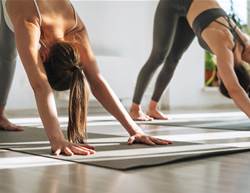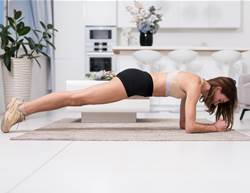Strength training is one of the best investments for midlife and beyond. It helps maintain muscle, supports bones, steadies balance and keeps joints happy so everyday tasks feel easier. It also nudges metabolism, improves insulin sensitivity and boosts mood.
Short on time? This three-move circuit delivers head-to-toe toning and a satisfying kilojoule burn with just a pair of dumbbells.
How to start
- Warm up 3–5 minutes with marching on the spot, shoulder rolls and easy squats. Add a few hip hinges to prime your back and glutes.
- Choose a weight you can lift with good form for 8–12 reps, with the last 2 reps feeling challenging. Beginners often do well with 1–3 kg dumbbells.
- Do 2–3 rounds of the three moves below. Rest 30–45 seconds between sets. Train two or three days a week on non-consecutive days.
- Keep breathing. Exhale on the effort, inhale on the return. If you have a health condition or injury, check with your GP or physio before starting.
Move 1: Overhead press with bicep curl
Stand tall with feet just wider than hips, core braced. Hold dumbbells at shoulder height, knuckles facing forward. Press straight overhead, keeping elbows close to your ears. Lower back to shoulders. Rotate palms forward, lower hands toward hips, then curl back to shoulders with elbows tucked to your sides.
Optional
Step side to side or add gentle lateral lunges for extra lower-body movement.
Form cues
Ribs down, glutes lightly squeezed, neck long. Avoid leaning back or flaring the ribs.
Reps
8–12 presses + curls equals one set.
Make it easier
Press one arm at a time or perform the curl seated.
Make it harder
Slow the lowering phase to 3 seconds or add a brief pause overhead.
Move 2: Tricep kickback
Stand in a mini squat, hinge slightly from the hips with a flat back. Hold dumbbells by your hips with elbows bent and pointing behind you.
Pin elbows to your sides and straighten your arms until fully extended. Squeeze the back of the arms, then return with control.
Form cues
Shoulders down, chest open, eyes to the floor to keep a neutral neck. Only the forearms move.
Reps
10–15 each set.
Make it easier
Use one weight held in both hands or support your free hand on a bench or chair.
Make it harder
Add a 1–2 second squeeze at full extension or progress to a single-leg hinge for balance work.
Move 3: Reverse Fly (Back Fly)
Take a split stance and hinge forward a fraction, dumbbells hanging with palms facing each other.
With a soft bend in the elbows, raise arms out to the sides to form a wide “T,” squeezing shoulder blades together. Lower slowly.
Form cues
Move through the shoulders, not the lower back. Keep torso still and belly lightly braced.
Reps
8–12 each set.
Make it easier
Use lighter weights or perform seated and hinged.
Make it harder
Tempo 3 seconds up, 3 seconds down or add a small hold at the top.
Programming tips
Progress each week by adding 1–2 reps per set or choosing a slightly heavier weight once you can complete 12 reps with solid form.
Set a 10-minute timer and cycle through the three moves with minimal rest. Balance your week with a 20–30 minute walk or ride on non-lifting days to support heart health and recovery.
Cool-down and recovery
Finish with shoulder stretches, chest opener against a wall and a gentle hamstring stretch. Rehydrate, include protein with your next meal, and expect mild next-day muscle soreness that settles within 48 hours. If pain is sharp or lingers, ease back and check with a professional.
Consistency over perfection wins. Two or three short sessions each week will help you stand taller, lift more with confidence and feel strong in your everyday life.










